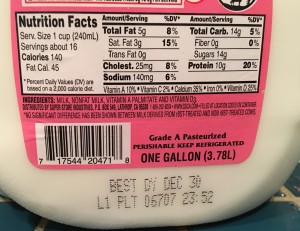 This month the Planting Seeds blog is featuring stories on food security, nutrition, and efforts to reduce food waste. CDFA’s Office of Farm to Fork is committed to helping all Californians access healthy and nutritious California-grown food by connecting consumers, school districts, and others directly with California’s farmers and ranchers.
This month the Planting Seeds blog is featuring stories on food security, nutrition, and efforts to reduce food waste. CDFA’s Office of Farm to Fork is committed to helping all Californians access healthy and nutritious California-grown food by connecting consumers, school districts, and others directly with California’s farmers and ranchers.
The USDA estimates that 30 percent of the food supply is lost or wasted at the retail and consumer levels. One source is of this consumers or retailers throwing away wholesome food because of confusion about the meaning of dates displayed on the label.
What is Food Product Dating?
Two types of product dating may be shown on a product label. “Open Dating” is a calendar date applied to a food product by the manufacturer or retailer. The calendar date provides consumers with information on the estimated period of time for which the product will be of best quality and to help the store determine how long to display the product for sale. “Closed Dating” is a code that consists of a series of letters and/or numbers applied by manufacturers to identify the date and time of production.
Does Federal Law Require Dating?
Except for infant formula, product dating is not required by federal regulations. For meat, poultry, and egg products under the jurisdiction of the Food Safety and Inspection Service (FSIS), dates may be voluntarily applied provided they are labeled in a manner that is truthful and not misleading and in compliance with FSIS regulations1. To comply, a calendar date must express both the month and day of the month. In the case of shelf-stable and frozen products, the year must also be displayed. Additionally, immediately adjacent to the date must be a phrase explaining the meaning of that date such as “Best if Used By.”
Are Dates for Food Safety or Quality?
Manufacturers provide dating to help consumers and retailers decide when food is of best quality. Except for infant formula, dates are not an indicator of the product’s safety and are not required by Federal law.
How do Manufacturers Determine Quality Dates?
Factors including the length of time and the temperature at which a food is held during distribution and offered for sale, the characteristics of the food, and the type of packaging will affect how long a product will be of optimum quality. Manufacturers and retailers will consider these factors when determining the date for which the product will be of best quality.
For example, sausage formulated with certain ingredients used to preserve the quality of the product or fresh beef packaged in a modified atmosphere packaging system that helps ensure that the product will stay fresh for as long as possible. These products will typically maintain product quality for a longer period of time because of how the products are formulated or packaged.
The quality of perishable products may deteriorate after the date passes, however, such products should still be safe if handled properly. Consumers must evaluate the quality of the product prior to its consumption to determine if the product shows signs of spoilage.
What Date-Labeling Phrases are Used?
There are no uniform or universally accepted descriptions used on food labels for open dating in the United States. As a result, there are a wide variety of phrases used on labels to describe quality dates.
Examples of commonly used phrases:
- A “Best if Used By/Before” indicates when a product will be of best flavor or quality. It is not a purchase or safety date.
- A “Sell-By” date tells the store how long to display the product for sale for inventory management. It is not a safety date.
- A “Use-By” date is the last date recommended for the use of the product while at peak quality. It is not a safety date except for when used on infant formula as described below.
What Date-Labeling Phrase does FSIS Recommend?
USDA estimates food loss and waste at 30 percent of the food supply lost or wasted at the retail and consumer levels. One source of food waste arises from consumers or retailers throwing away wholesome food because of confusion about the meaning of dates displayed on the label. To reduce consumer confusion and wasted food, FSIS recommends that food manufacturers and retailers that apply product dating use a “Best if Used By” date. Research shows that this phrase conveys to consumers that the product will be of best quality if used by the calendar date shown. Foods not exhibiting signs of spoilage should be wholesome and may be sold, purchased, donated and consumed beyond the labeled “Best if Used By” date.
Safety After Date Passes
With an exception of infant formula (described below), if the date passes during home storage, a product should still be safe and wholesome if handled properly until the time spoilage is evident. Spoiled foods will develop an off odor, flavor or texture due to naturally occurring spoilage bacteria. If a food has developed such spoilage characteristics, it should not be eaten.
Can Food be Donated After the Date Passes?
Yes. The quality of perishable products may deteriorate after the date passes but the products should still be wholesome if not exhibiting signs of spoilage. Food banks, other charitable organizations, and consumers should evaluate the quality of the product prior to its distribution and consumption to determine whether there are noticeable changes in wholesomeness (Food Donation Safety Tips).


